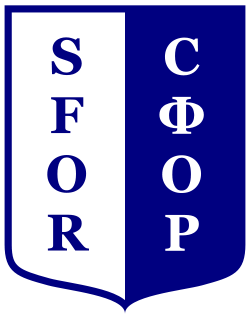Structure and history
SFOR was established in Security Council Resolution 1088 on 12 December 1996. It succeeded the much larger Implementation Force IFOR which was deployed to Bosnia and Herzegovina on 20 December 1995 with a one-year mandate. The commanders of the SFOR, who each served one-year terms, were General William W. Crouch, General Eric Shinseki, General Montgomery Meigs, Lt. General Ronald Adams, Lt. General Michael Dodson, Lt. General John B. Sylvester, Lt. General William E. Ward, Major General Virgil Packett and Brigadier General Steven P. Schook.
SFOR operated in support of NATO Operation Joint Guard and Operation Joint Forge.
Troop levels were reduced to approximately 12,000 by the close of 2002, and to approximately 7,000 by the close of 2004. During NATO's 2004 Istanbul Summit the end of the SFOR mission was announced.
It was replaced by the European Union's EUFOR Althea, on 2 December 2004 at NATO HQ, Camp Butmir, Sarajevo, B-H. Operation Joint Forge was succeeded by the EU's Operation Althea.
SFOR was divided into three zones of operation:
- Mostar MND(S) – Italian, French, German, Spanish
- Banja Luka MND(W) – American, British, Canadian, Czech, Dutch. The British code name for their activities in IFOR was Operation Resolute and SFOR was Operation Lodestar (to June 1998) and Operation Palatine (from June 1998). The Canadian mission was named Operation Palladium (1996 to 2004).
- Tuzla MND(N) – American, Turkish, Polish, Russian, Norwegian, Swedish, Danish, Finnish.
(Some units had troops stationed outside the assigned zone)
The three AOs were known collectively as Multi-National Divisions until the end of 2002 where they were reduced in scope to Multi-National Brigades.
SFOR operated under peace enforcement, not peacekeeping, rules of engagement. For example, it was cleared, in 1997, to neutralise Serb radio-television facilities. [2] During its mandate, SFOR arrested 29 individuals who were charged with war crimes. Those arrested were transferred to the International Criminal Tribunal for the former Yugoslavia in the Netherlands.
U.S. service members serving in SFOR were awarded the Armed Forces Expeditionary Medal and the NATO Medal.
SFOR operated as part of Operation Joint Guard and Operation Joint Forge. As time progressed, the numbers of troops allotted to SFOR declined. On 2 December 2004, SFOR disbanded and its functions were assumed by military units from the European Union organized as European Union Forces (EUFOR).
Air operations
Several sequential air operations supported the stabilization efforts. [3]
This page is based on this
Wikipedia article Text is available under the
CC BY-SA 4.0 license; additional terms may apply.
Images, videos and audio are available under their respective licenses.


